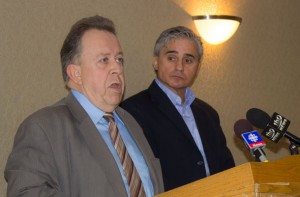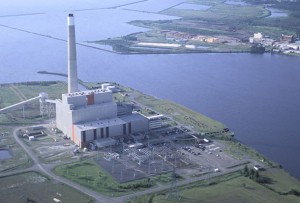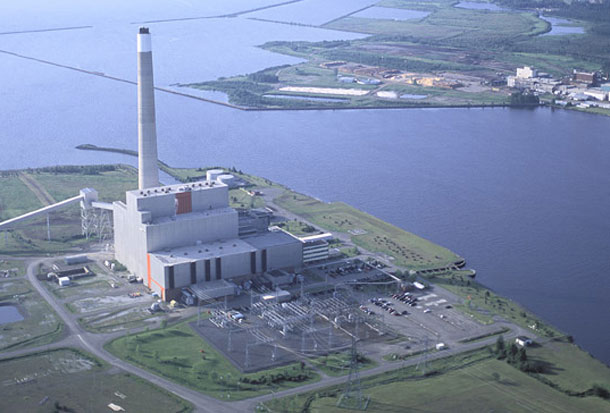
Thunder Bay OPG Power Plant Plans
THUNDER BAY – The conversion of the Thunder Bay Ontario Power Generating Station has been in the spotlight since Friday when Bill Mauro and Michael Gravelle announced a plan to convert the plant from coal to enhanced bio-mass.
Yesterday in the Ontario Legislature, Thunder Bay Atikokan MPP Bill Mauro was up to gather information from Energy Minister Chiarelli.
Mauro stated, “Over the next decade, there’s the potential for a number of mining projects to come on stream in northwestern Ontario, and while there continues to be disagreement over the energy needs of northwestern Ontario in the next five to 10 years, we need to ensure that Thunder Bay and northwestern Ontario are positioned for the economic growth and job creation these projects may bring”.
The move comes as the Chamber of Commerce in Thunder Bay questions parts of the decision, asking for details. Chamber President Charla Robinson states, “The Thunder Bay Generating Station’s approved fuel contract will allow the station to run at only two percent of capacity. Currently, the plant can produce up to 306MW of energy; however, after the conversion, maximum generation will top out at 150MW with restrictions on the amount of fuel available. The bottom line is that while the lights will be on for 365 days, the plant can only run at full power for 7.3 days each year”.
Robinson stated, “The good news is that keeping the station operational for five years will retain jobs at the plant, generate much needed taxes for city coffers and allow expansion at a later date. The bad news is that the plant will be transitioned to a “peaking plant” and will only be turned on when energy demand is greater than the supply available through other sources”.
The debate appears centred on timing and demand for power. Mauro stated, “With the Thunder Bay and Atikokan generating station conversions now in place, I feel we’re well positioned to move forward and prepared for the mining expansion that may come in the northwest. The five-year contract will allow us to monitor the region’s energy demands over the near term and make the appropriate decision at that time.”
Common Voice Northwest, the City of Thunder Bay and now the Chamber of Commerce appear to be suggesting there is greater demand for power than the plant and current hydro capacity can produce.
The Ontario Government appears more willing to wait longer and make a decision over the next five years.
Chamber President on OPG Plant
NORTHERN ONTARIO DEVELOPMENT
Mr. Bill Mauro: My question is for the Minister of Energy. Minister, in 2003, all three political parties and all three political leaders committed to closing all coal-fired energy in Ontario, and two of the five plants producing energy that way were in my riding of Thunder Bay–Atikokan.
For 10 years I’ve been working on the conversion, the maintenance and the sustainability of both of the coal plants in my riding, including the plant in Atikokan, and that conversion, I’m pleased to say, is well under way.

Over the next decade, there’s the potential for a number of mining projects to come on stream in northwestern Ontario, and while there continues to be disagreement over the energy needs of northwestern Ontario in the next five to 10 years, we need to ensure that Thunder Bay and northwestern Ontario are positioned for the economic growth and job creation these projects may bring.
Last Friday I was pleased to announce, along with my colleague from Thunder Bay–Superior North, that the Thunder Bay generating station will be converted to burn advanced biomass fuel.
Minister, for the benefit of the House, could you please share some of the work that went into ensuring the future of the Thunder Bay generating station?
Hon. Bob Chiarelli: I thank the member from Thunder Bay–Atikokan for his question. The member and his colleague the Minister of Northern Development and Mines have been advocating on this issue for many years—unlike the third party, who only seem to have discovered it yesterday—and I want to commend them for their work on this file.
Friday’s announcement was the result of the member’s strong leadership over the past 10 years, as well as that of his colleague from Thunder Bay, and months of working with the local stakeholders and residents and Ontario’s energy agencies.
The conversion to advanced biomass is another step in reducing dirty coal burning in Ontario and puts our province on the leading edge of worldwide biomass research. The continued operation of this plant will ensure that Thunder Bay has the power it needs to support future economic expansion.
The Speaker (Hon. Dave Levac): Supplementary?
Mr. Bill Mauro: Minister, thank you for the response. Having worked on this issue for 10 years, I know how important Friday’s announcement was for the constituents in my riding and for the future of northwestern Ontario. Not only will this cost-effective conversion to advanced biomass ensure that Thunder Bay has the supply of clean and reliable electricity it needs, it will secure significant employment until at least 2020.
With the Thunder Bay and Atikokan generating station conversions now in place, I feel we’re well positioned to move forward and prepared for the mining expansion that may come in the northwest. The five-year contract will allow us to monitor the region’s energy demands over the near term and make the appropriate decision at that time.
Can the minister please update the House on what other steps our government has taken to ensure that northwestern Ontario has a supply of clean, reliable and affordable electricity?
Hon. Bob Chiarelli: Iain Angus, the chair of the Northwest Energy Task Force, states, “Five years is really good. A commitment to keep the plant alive is really good.”
We expect the converted unit will begin operating in 2015 on a five-year contract, helping ensure that the residents of Thunder Bay continue to have a clean, reliable, cost-effective supply of electricity.
To ensure the region has the energy it needs for new mining projects, we have also committed to building a new transmission line between Wawa and Thunder Bay, which will provide an additional 650 megawatts of capacity for the northwest. The North of Dryden report lays out additional options for new generation and transmission lines over the short and long term, including the connection of remote communities in the region.
Our government has taken action to ensure that northwestern Ontario has the energy they need when they need it, and we’ll continue to work to ensure that the capacity is there for mining developments in the future.













